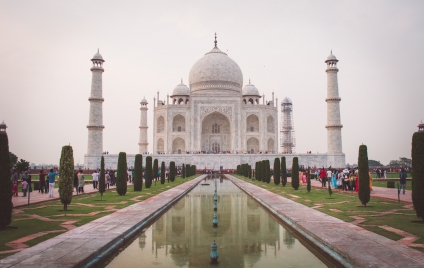India is one of the world's oldest civilizations. The Indian culture, often labeled as an amalgamation of several various cultures, spans across the Indian subcontinent and has been influenced and shaped by a history that is several thousand years old. Throughout the history of India, Indian culture has been heavily influenced by Dharmic religions. They have been credited with shaping much of Indian philosophy, literature, architecture, art and music. Greater India was the historical extent of Indian culture beyond the Indian subcontinent. This particularly concerns the spread of Hinduism, Buddhism, architecture, administration and writing system from India to other parts of Asia through the Silk Road by the travellers and maritime traders during the early centuries of the Common Era. To the west, Greater India overlaps with Greater Persia in the Hindu Kush and Pamir Mountains. During the medieval period, Islam played a significant role in shaping Indian cultural heritage. Over the centuries, there has been significant integration of Hindus, Jains, and Sikhs with Muslims across India.
Religions
India is the birthplace of Hinduism, Jainism and Sikhism, collectively known as Indian religions. Indian religions are a major form of world religions along with Abrahamic ones. Today, Hinduism and Buddhism are the world's third and fourth-largest religions respectively, with over 2 billion followers altogether, and possibly as many as 2.5 or 2.6 billion followers. India is one of the most religiously diverse nations in the world, with some of the most deeply religious societies and cultures. Religion plays a central and definitive role in the life of many of its people. According to the 2011 census, 80% of the population of India practice Hinduism. Islam (14.2%), Christianity (2.3%), Sikhism (1.7%), Buddhism (0.7%) and Jainism (0.4%) are the other major religions followed by the people of India. Many tribal religions, such as Sarnaism, are found in India, though these have been affected by major religions such as Hinduism, Buddhism, Islam and Christianity. Jainism, Zoroastrianism, Judaism, and the Bahá'í Faith are also influential but their numbers are smaller. Atheism and agnostics also have visible influence in India, along with a self-ascribed tolerance to other faiths. Atheism and agnosticism have a long history in India and flourished within Śramaṇa movement. The Cārvāka school originated in India around the 6th century BCE. It is one of the earliest form of materialistic and atheistic movement in ancient India. Sramana, Buddhism, Jainism, Ājīvika and some schools of Hinduism consider atheism to be valid and reject the concept of creator deity, ritualism and superstitions. India has produced some notable atheist politicians and social reformers. According to the 2012 WIN-Gallup Global Index of Religion and Atheism report, 81% of Indians were religious, 13% were not religious, 3% were convinced atheists, and 3% were unsure or did not respond.
Family structure and marriage
For generations, India has a prevailing tradition of the joint family system. It is a system under which extended members of a family – parents, children, the children's spouses and their offspring, etc. – live together. Usually, the oldest male member is the head in the joint Indian family system. He mostly makes all important decisions and rules, and other family members are likely abide by them. In a 1966 study, Orenstein and Micklin analysed India's population data and family structure. Their studies suggest that Indian household sizes had remained similar over the 1911 to 1951 period. Thereafter, with urbanisation and economic development, India has witnessed a break up of traditional joint family into more nuclear-like families. Sinha, in his book, after summarising the numerous sociological studies done on Indian family, notes that over the last 60 years, the cultural trend in most parts of India has been an accelerated change from joint family to nuclear families, much like population trends in other parts of the world. The traditional large joint family in India, in the 1990s, accounted for a small percent of Indian households, and on average had lower per capita household income. He finds that joint family still persists in some areas and in certain conditions, in part due to cultural traditions and in part due to practical factors. Youth in lower socio-economic classes are more inclined to spend time with their families than their peers due to differing ideologies in rural and urban parenting.





